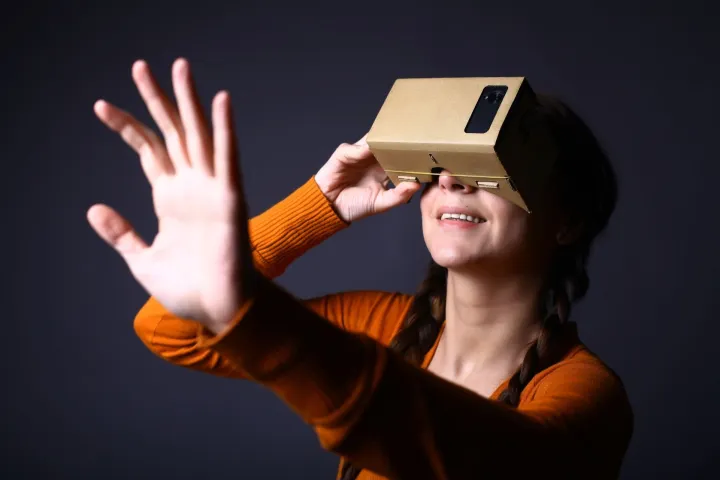
by admin | May 25, 2023 | News
In today’s rapidly advancing technological landscape, Augmented Reality (AR) and Virtual Reality (VR) have emerged as prominent players, revolutionizing the way we interact with digital content. These two technologies can be confusing to most. While both AR and VR offer immersive experiences, they differ significantly in their approach and application. In this blog post, we will delve into the contrasting characteristics of AR and VR, providing clear examples to help you understand their unique features and use cases.
AR: Bridging the Gap between Real and Digital Worlds Augmented Reality (AR) enhances our perception of reality by overlaying digital content onto the physical environment. By blending virtual elements with the real world, AR provides an interactive and contextually enriched experience. Imagine a tourism company using AR to create an immersive experience for visitors exploring a historical site. Through a mobile app, users can point their devices at different landmarks, and AR overlays historical information, virtual characters, and interactive elements onto real-world surroundings. This not only enhances visitors’ engagement but also provides educational and entertaining content, making the experience memorable and captivating. AR offers immense potential in the tourism, government, and entertainment sectors, allowing them to create unique and compelling experiences for their audiences.
VR: Immersion into Virtual Environments Virtual Reality (VR) transports users to entirely simulated environments, offering a fully immersive and often interactive experience. With the help of headsets and motion-tracking technology, VR creates a sense of presence, allowing users to explore and interact with computer-generated worlds. Here’s an example that illustrates how VR can be leveraged to benefit those in the entertainment and tourism sectors. Imagine an entertainment venue seeking to enhance its experience. By incorporating VR technology, the company can offer thrilling additional threads to its storylines, taking visitors through fantastical landscapes and breathtaking scenarios that continue even after they leave. VR enables unique and memorable experiences while also optimizing the use of physical space and resources.
Comparing AR and VR While both AR and VR offer immersive experiences, they differ primarily in their level of immersion and interaction. AR enhances the real world by overlaying virtual elements, allowing users to maintain a connection with their physical surroundings. VR, on the other hand, fully immerses users in a virtual environment, providing a sense of presence and enabling them to explore and interact within that environment. Depending on the specific goals and requirements, AR and VR can be strategically employed to deliver engaging and impactful experiences.
To discover how Alt Ethos can unlock the potential of AR, VR, and other immersive technologies for your organization, click the button below to schedule a free consultation with our experts. Our team of award-winning professionals will provide personalized recommendations tailored to your specific industry and objectives. Don’t miss out on the opportunity to tap into the future of experiences and transform your organization. Schedule your free consultation today!
Schedule a FREE Consultation

by admin | Jan 10, 2023 | News
The Future of Entertainment in the Metaverse
The concept of a “metaverse” has been around for decades, but in recent years, advancements in technology have brought it closer to becoming a reality. The metaverse is essentially a virtual world where users can interact, play, and even live in a fully immersive and interactive environment. While the metaverse is still in its infancy, the potential for the future of entertainment is enormous.
One of the key benefits of the metaverse is that it allows for limitless creativity and experimentation in the realm of entertainment. In the physical world, there are many constraints and limitations on what is possible to create and experience. But in the metaverse, anything is possible. From virtual reality theme parks to interactive movies and games, the opportunities for entertainment are endless.
Another major benefit of the metaverse is the potential for increased social interaction and connection. In the current online world, socialization mainly happens through screens, which can make it feel impersonal and isolating. But in the metaverse, users will be able to meet and interact with others in a more natural way, creating a deeper sense of connection and community.
The metaverse also has the potential to revolutionize the way we consume and interact with media. Instead of passively watching a movie or TV show, users will be able to actively participate and become part of the story. This could lead to a more engaging and personalized form of entertainment, where the user’s choices and actions have a direct impact on the outcome of the experience.
Despite all the exciting possibilities of the metaverse, there are also some concerns and challenges to overcome. One major issue is the potential for addiction, as the metaverse could provide a more engaging and immersive form of entertainment than the physical world. Another concern is the potential for a lack of privacy and security in the metaverse, as users share personal information and potentially sensitive data.
In conclusion, the future of entertainment in the metaverse is an exciting and limitless prospect. It has the potential to revolutionize the way we create and consume entertainment, and bring people together in new and innovative ways. While there are concerns and challenges to overcome, it’s a glimpse of the future that can’t be ignored. As technology continues to evolve, the metaverse may soon become a place where people go not just to play, but to live and work. With the advancements in technology and the integration of 5G networks, the metaverse will become more accessible and the boundaries between the virtual world and the real world will be blurred.
It’s exciting to see how the technology will continue to evolve, and how entertainment in the metaverse will shape the way we interact, socialize and consume media in the future.

by admin | Aug 30, 2022 | News
While the connection fostered by these interactive experiences fuels our artistic souls, these creations have real-world fiscal benefits to companies. They offer scalable options, deeper engagement and retention, and unique opportunities for viral marketing in ways that are more effective than traditional mediums.
“Art galleries and museums have realised that built-in opportunities for “user-generated content” (UGC) can be profitable; as the artist Dena Yago wrote in a 2018 essay, “a company’s marketing plan may include a UGC campaign that broadcasts a call to action, or CTA … this response is often the creation of more content – the posting of selfies, photos and videos.”
Check out this great article by The Guardian which explores some of the world’s top immersive spaces and how they’re using technology to transform the way audiences experience art.
Inspiring immersive artists to check out:
TeamLab
James Turrell
Superblue
Random International
Alt Ethos is excited to be amongst these talented leaders in creating interactive and immersive projects. When you’re considering where your budget goes for the next event or long-term project, look to us to create mind-blowing immersive experiences that will bring you an ROI you can proudly report back to your stakeholders. We love to use technology to explore how we can engage wonder and create unexpected joy and connection. View more of our work on immersive projects and events around the country and world.


